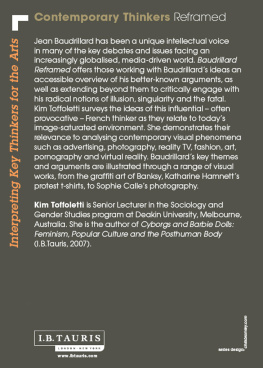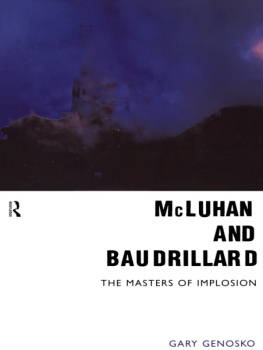Kim Toffoletti is Senior Lecturer in the Sociology and Gender Studies program at Deakin University, Melbourne, Australia. She is the author of Cyborgs and Barbie Dolls: Feminism, Popular Culture and the Posthuman Body (I.B.Tauris, 2007).
Baudrillard Reframed
Contemporary Thinkers Reframed Series
Deleuze Reframed ISBN: 978 1 84511 547 0
Damian Sutton & David Martin-Jones
Derrida Reframed ISBN: 978 1 84511 546 3
K. Malcolm Richards
Lacan Reframed ISBN: 978 1 84511 548 7
Steven Z. Levine
Baudrillard Reframed ISBN: 978 1 84511 678 1
Kim Toffoletti
Heidegger Reframed ISBN: 978 1 84511 679 8
Barbara Bolt
Kristeva Reframed ISBN: 978 1 84511 660 6
Estelle Barrett
Lyotard Reframed ISBN: 978 1 84511 680 4
Graham Jones
Published in 2011 by I.B.Tauris & Co. Ltd
6 Salem Road, London W2 4BU
175 Fifth Avenue, New York NY 10010
www.ibtauris.com
Distributed in the United States and Canada Exclusively by Palgrave Macmillan 175 Fifth Avenue, New York NY 10010
Copyright Kim Toffoletti, 2011
The right of Kim Toffoletti to be identified as the author of this work has been asserted by her in accordance with the Copyright, Designs and Patents Act 1988.
All rights reserved. Except for brief quotations in a review, this book, or any part thereof, may not be reproduced, stored in or introduced into a retrieval system, or transmitted, in any form or by any means, electronic, mechanical, photocopying, recording or otherwise, without the prior written permission of the publisher.
ISBN: 978 1 84511 678 1
eISBN: 978 0 85773 688 8
A full CIP record for this book is available from the British Library
A full CIP record for this book is available from the Library of Congress
Library of Congress catalog card: available
Contents
Acknowledgements
I am indebted to Victoria Grace for her interest in this project and for reading and commenting on drafts of the manuscript. Our many discussions about Baudrillards writing were invaluable to the development and refinement of my ideas, and enhanced the book immeasurably, although any errors that the reader might come across I claim as my own.
I would like to thank the School of Sociology and Anthropology at the University of Canterbury (New Zealand), who hosted me while I wrote this book. The collegiality and friendship of all the staff made my stay an enjoyable and productive one. Funding from Deakin University enabled me to take a sabbatical, and for that I am grateful. Thanks also to Susan Lawson and I.B.Tauris for commissioning me to undertake this project, and Philippa Brewster and Liza Thompson for seeing it through.
While in Christchurch, Magda and Grant provided a home away from home. Their wonderful dinners, excellent conversation and invitations to the rugby made for a memorable stay. Correspondence with friends and family back home kept me motivated. Special thanks to Eddy, Liz L., Pat, Lizzie T., Denny, Lisa, Caitlyn, Zac, Pamela and Brian for the emails, calls, visits, letters and photos.
Dan has contributed much to this book. As always, his useful advice and suggestions, especially with respect to pop culture events and occurrences, have made my writing sharper, more topical and focused. Without his commitment to me and my work I wouldnt be able to do what I do.
This book is dedicated to my parents Guido and Loretta Toffoletti, who have supported me always.
List of illustrations
. Gian Lorenzo Bernini, 165878, Church of SantAndrea al Quirinale (Rome), Copyright Superstock.
. CSI: Crime Scene Investigation , TV still. Dir. Jerry Bruckheimer, Copyright BFI.
. US soldier Lynndie England with prisoner, photo taken at Abu Ghraib prison, Baghdad, Anonymous source.
. Tracey Emin, My Bed (1999), Copyright Tracey Emin, photo Stephen White, courtesy White Cube.
. Sex and the City , TV still, Copyright BFI.
. Big Brother , TV still, Copyright BFI.
. George W. Bush with banner stating MISSION ACCOMPLISHED, news image (2003), Copyright Press Association.
Introduction
In November 2007, an Andy Warhol portrait of Elizabeth Taylor owned by Hugh Grant sold at a New York auction for 23.7 million dollars. The 1963 portrait, titled Liz , netted the actor a tidy profit of more than seven million dollars since he purchased it in 2001 (BBC News 2007). Aside from confirming the inflated state of the contemporary art market, this curious confluence of fame and image says something about the transformation of art into media spectacle. The event made news because of who was involved, while the merits of the artwork barely rated a mention. Some would deride the moment as a triumph of superficiality and surface. Jean Baudrillard, I suspect, would be drawn to this unholy trinity an icon of pop art, a star of the silver screen and a foppish British cad playing the game of simulation via the circuits of celebrity, image and culture. After all, wasnt it he who told us back in the eighties that image is everything and signs rule? Hes also notorious for informing the world that the Gulf War didnt happen, well at least not as we imagined it did. In the popular mindset, Baudrillards corpus of ideas has often been reduced to these two observations. Yet he has far more to offer in assessing the state of the world through our visual surroundings. Throughout his career his writing has addressed many aspects of visual culture and tackled a range of issues emerging from an image-based society.
Born in the French town of Remis, Jean Baudrillard (19292007) earned his academic stripes training under Henri Lefebvre. His reputation was forged amidst the French intellectual scene of the 1960s, alongside contemporaries like Jacques Derrida, Gilles Deleuze and Michel Foucault. In later years he gained widespread appeal as a social commentator and critic, writing on all sorts of contemporary concerns like AIDS, reality TV, mad cow disease, war and pornography. His ideas have influenced, among other things, the way that we think about the real, the virtual, communication technologies, consumerism and the media. For this reason, his writings are indispensable to a study of modern and postmodern image society.
This book sets out to explore the impact of Baudrillards ideas in the visual arts and culture arena. It considers what he has contributed to studies of the visual, and the relevance and applicability of his theories to analysing images. It goes about this in two ways. Firstly, it unpacks Baudrillards key ideas and approaches in the process of analysing visual texts. The images discussed in Baudrillard Reframed span the fields of visual arts and popular culture, drawing on examples from television, art, film and advertising. Secondly, it appraises Baudrillards writings about our visual world of signs and images, of which there are many, including his influential theory of simulation and his thoughts on televised images of war, the fashion system, reality TV, advertising and contemporary art.
By introducing the reader to what Baudrillard has written about our changing visual landscape, as well as applying his key concepts to a range of examples, this volume offers a new perspective on his ideas. It shows that he is deeply invested in exploring the nature of representation, and highlights the significance of his contributions to understanding how the visual world operates. As well as offering us another vision of how image society works, Baudrillard reveals himself to be visually aware. Just as putting a new frame around a picture can change the way we see it, this series approaches well-known thinkers from a different angle, so that we might view them in a new light and perhaps with a renewed appreciation. But as anyone who has read Baudrillard will know, his ideas dont always lend themselves to the most straightforward or obvious modes of interpretation and analysis. Attempting to frame Baudrillard to pin him down, set him up or catch him out is a futile exercise. Why? Because a reader will never fully get to know Baudrillards work by trying to approach it relative to existing cultural co-ordinates or an already-familiar set of values and meanings. Baudrillard sits outside conventional frames of reference.










